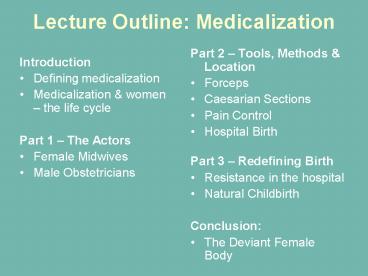Lecture Outline: Medicalization - PowerPoint PPT Presentation
Title:
Lecture Outline: Medicalization
Description:
Lecture Outline: Medicalization Part 2 Tools, Methods & Location Forceps Caesarian Sections Pain Control Hospital Birth Part 3 Redefining Birth – PowerPoint PPT presentation
Number of Views:58
Avg rating:3.0/5.0
Title: Lecture Outline: Medicalization
1
Lecture Outline Medicalization
- Part 2 Tools, Methods Location
- Forceps
- Caesarian Sections
- Pain Control
- Hospital Birth
- Part 3 Redefining Birth
- Resistance in the hospital
- Natural Childbirth
- Conclusion
- The Deviant Female Body
- Introduction
- Defining medicalization
- Medicalization women the life cycle
- Part 1 The Actors
- Female Midwives
- Male Obstetricians
2
Defining Medicalization
- key concept in medical sociology
- normal health condition redefined as a medical
condition - process of colonization/ power dynamic
- the female lifecycle medicalization
3
Impact of medicalization?
- women physicians
- power new medical specialization
- the compartmentalized body
- ownership of health
4
The Actors Female Midwives
- tradition of women attending childbirth to 14th
century - Legitimacy through relational authority
- midwives as healers.
5
The Actors Male Obstetricians
- male obstetricians, 17th-19th century
- birth - natural or potentially pathological?
- Obstetrics as a specialization
6
The Actors Male Obstetricians
- Full-term infant in utero
- Engraving by Jan van Rymsdyk, in William Hunter,
Atlas of the Gravid Uterus, 1774.
7
Tools, Methods Location Forceps
- tools used in birthing process in Greco-Roman
times - obstetrical forceps 17th century invention
- technological monopolies
8
Tools, Methods LocationImaging Technology
- ultrasound technology - 1960s
- fetal monitors -1960s
- power intervention
9
Tools, Methods Location Caesarian Section
- history
- current statistics for c-sections 26 in US
22.5 in Canada, 22 in UK, 47 in China
10
Too Posh to Push?
11
Tools, Methods Location Pain Control
- history
- Queen Victoria
12
Tools, Methods Location Hospital Birth
- shift by 1930s
- routine procedures birthing position
- bureaucratization management of birth
13
Redefining Birthresistance in the hospital
- anthropologist Emily Martin
- female strategies
- female perceptions
14
Redefining Birthnatural childbirth
- 1960s natural childbirth Grantley Dick-Read,
Ferdinand Lamaze, Frederique Leboyer, Michael
Odent - Pre-natal education
- hospital changes
15
Personal Choice Personal Power BCs Home Birth
Movement, 1970-90
Megan Davies York University
16
We hadnt taken to the woods just for a change
of scenery and a different way of life. We
expected to get closer to nature, to each other
and our feelings and develop entirely new ways
of being and experiencing the world free of the
cities, of capitalism, of racism, industrialism,
they had to be for the better. Mark Vonnegut
, The Eden Express
17
Kootenay Quilt Detail
18
For me midwifery was about personal choice and
personal power. Everything you do, you do
naturally whole food, kerosene lamps,
outhouses When you look to the medical or
educational system or any system to have all the
answers for you, I think you end up with less
freedom.
Leslie Campos, home births
1979, 1989, 1991
19
To be somewhere where I could be myself there
is something about personal growth and becoming -
becoming a bigger version of yourself. This is
my choice. This is me having this baby and taking
responsibility for the choices and who I become
through the process that is really
important. Lisa Farr, home birth 1981
20
Responsible Home-Centred Childbirth Published by
the Kootenay Childbirth Counselling Centre
21
Home is a temple. And when you have your child
at home with the music you want, the candles
you want, the pace you want, the people you
trust more than anything it is completely
un-violated, sacred space. Pamela
Stevenson, home birth 1978
22
Blessing Way Ceremony About 10 years ago,
this ceremony sprang up in our culture as a
kind of new age baby shower, but with an
intimate powerful focus on the birthing
family. This concurred with a general trend to
embrace create traditions as a way of
understanding celebrating changes or passages
events in our lives.
23
Whose Body?
24
- Disintegration starts and the entire lining
begins to slough The endometrial arterioles
dilate, resulting in hemorrhage through the
weakened capillary walls - The mechanisms which guide the remarkable
cellular transformation from spermatid to mature
sperm remain uncertain Perhaps the most amazing
characteristic of spermatogenesis is its sheer
magnitude - Arthur Vander, Human Physioology, 1980































